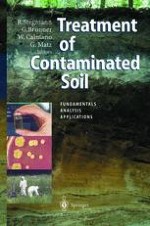2001 | Book
Treatment of Contaminated Soil
Fundamentals, Analysis, Applications
Editors: Prof. Dr.-Ing. Rainer Stegmann, Prof. Dr.-Ing. Gerd Brunner, Prof. Dr.-Ing. Wolfgang Calmano, Prof. Dr.-Ing. Gerhard Matz
Publisher: Springer Berlin Heidelberg
Included in: Professional Book Archive
